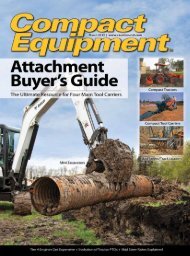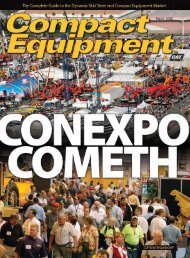CE EQUIPMENT CONNECTION - Compact Equipment
CE EQUIPMENT CONNECTION - Compact Equipment
CE EQUIPMENT CONNECTION - Compact Equipment
Create successful ePaper yourself
Turn your PDF publications into a flip-book with our unique Google optimized e-Paper software.
Few applications have a wider range of available horsepower<br />
options than generator sets. These units can run<br />
anywhere from 1 to 10,000 hp and beyond, but the typical<br />
contractor or hobby farmer, for example, is more likely to<br />
use a generator in the 20- to 150-hp range.<br />
Gen sets have always been a fairly simple application<br />
for engines. Some important application requirements<br />
for other equipment — torque, power bulge and fuel<br />
economy — aren’t as critical when working with gen<br />
sets. What’s most important is that the engine is durable,<br />
reliable, cost-effective, quiet and emissions-compliant.<br />
For most gen set users, high-performance characteristics<br />
are a bonus.<br />
“Today’s Tier 3 engines are much more technologically<br />
advanced than their Tier 1 and Tier 2 counterparts,”<br />
says Matt Arnold, product planner at John Deere Power<br />
Systems, which manufactures generator-drive engines<br />
from 36 to 617 hp. “Some Tier 3 engine models have<br />
technology such as cooled exhaust gas recirculation<br />
[EGR] and variable geometry turbochargers [VGT], but<br />
in the cost-driven gen set market, many customers are<br />
looking for emissions-compliant engines that aren’t as<br />
full-featured.”<br />
Because the EPA took a phased approach to emissions<br />
compliance, the Tier 3 deadline for some horsepower<br />
ranges of engines just came into effect in January 2008.<br />
Here is a quick breakdown of when off-highway engines<br />
common to compact equipment users have to meet EPA<br />
regulations. Engines of:<br />
1. 24 hp and below entered Tier 2 in 2005 and skipped Tier<br />
3, going right to Final Tier 4 in 2008.<br />
2. 25 to 99 hp entered Tier 2 in 2004 — in 2008, the lower<br />
end of this range jumped to Interim Tier 4 and the<br />
higher end of this range had to meet Tier 3.<br />
3. 100 to 174 hp entered Tier 2 in 2003 and Tier 3 in<br />
2007.<br />
For low-horsepower Tier 3 engines, mechanical models<br />
are still available. Some manufacturers offer an Interim<br />
Tier 4 engine in 43 hp for prime power applications and 48<br />
hp for standby power applications. These engines feature<br />
mechanical controls, a two-valve cylinder head, a fi xed<br />
geometry turbocharger and a mechanical rotary pump fuel<br />
system.<br />
Tier 3 engines with electronic controls are available<br />
in mid-range horsepower options. These engines feature<br />
either two-valve or four-valve cylinder heads depending on<br />
model, electronic unit pump or high-pressure common-rail<br />
fuel systems, full-authority electronic controls, a multiple<br />
injection strategy and a fi xed geometry turbocharger.<br />
High-technology options are more common in the<br />
higher horsepower engines than in the type of gen sets<br />
contractors and other users of compact equipment are<br />
likely to own. These engines feature a four-valve cylinder<br />
head, full-authority electronic controls, variable geometry<br />
turbochargers and cooled exhaust gas recirculation.<br />
Common gen set applications for contractors include<br />
temporary jobsite power supply for lighting and tool usage.<br />
Standby gen sets are usually stationary units meant to<br />
serve as backup when the power goes out. Having a backup<br />
power supply is much more crucial for some people than<br />
for others. Animal farmers are one example of gen set users<br />
who rely heavily on reliable standby power.<br />
Todd Honkomp is a production supervisor with Pro Pork<br />
Associates, an Iowa hog management farm. They have a<br />
gen set powered by a John Deere 4.5L diesel engine. “We<br />
need the standby generator in case of a power outage,”<br />
Honkomp says. “An hour without ventilation or heat for<br />
our baby pigs and we could have animal losses.”<br />
Pro Pork Associates is not content to let the generator<br />
sit idle waiting for an emergency outage; the local rural<br />
electric cooperative taps into the generator to fi ll peak<br />
demand.<br />
“They have a switch they can throw that starts up the<br />
generator and sends power out onto their lines,” Honkomp<br />
explains. “In return, we get about a 30 percent discount on<br />
our utility bill every month.”<br />
Having a reliable generator is always important, but it<br />
became especially important to Pro Pork Producers when<br />
its utility company began to count on them. If the utility<br />
hits that switch and the generator’s engine doesn’t start,<br />
Pork Pro Associates loses their discount for that month.<br />
“We quickly saw the importance for having that engine<br />
properly maintained,” Honkomp says. “We sure don’t want<br />
to lose that discount. That’s why I worked with Greenway<br />
[the local John Deere dealership] to keep the engine and<br />
generator ready to run.”<br />
Honkomp’s gen set runs about 350 hours a year and has<br />
never broken down. The engine’s reliability is what’s most<br />
important to Honkomp, as is the case with most gen set<br />
customers.<br />
Jennifer Oredson is a technical writer with Two Rivers Marketing,<br />
Des Moines, Iowa.<br />
High-technology options are more common in the higher<br />
horsepower engines than in the type of gen sets contractors and<br />
other users of compact equipment are likely to own. These engines<br />
feature a four-valve cylinder head, full-authority electronic controls,<br />
variable geometry turbochargers and cooled exhaust gas recirculation.<br />
compactequip.com January 2008 <strong>Compact</strong> <strong>Equipment</strong> 47








